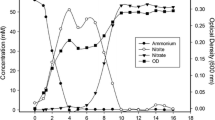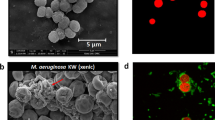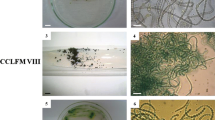Abstract
Pseudo-nitzschia multiseries loses most of its ability to produce domoic acid when it is cultured axenically. However, domoic acid production recovers when bacteria from the original culture are reintroduced to axenic cultures, indicating a bacterial association with domoic acid production in this species. In order to determine the role of bacteria in domoic acid production, an axenic strain prepared from a nonaxenic strain of P. multiseries was inoculated into media in cellophane tubes, which were then placed in a bottle containing the original nonaxenic culture. Both strains showed characteristic domoic acid production similar to that previously observed. Domoic acid level in the cells of the axenic strain in the tubes was much smaller than that of the cells outside the tubes. These results show that direct contact between living bacteria and P. multiseries is necessary for producing high levels of domoic acid in P. multiseries.




Similar content being viewed by others
References
Wright JLC, Boyd RK, De Freitas ASW, Falk M, Foxall RA, Jamieson WD, Laycock MV, McCulloch AW, McInnes AG, Odense P, Pathak VP, Quilliam MA, Ragan MA, Sim PG, Thibault P, Walter JA, Gilgan M, Richard DJA, Dewar D (1989) Identification of domoic acid, a neuroexcitatory amino acid, in toxic mussels from eastern Prince Edward Island. Can J Chem 67:481–490
Martin JL, Haya K, Burridge LE, Wildish DJ (1990) Nitzschia pseudodelicatissima—a source of domoic acid in the Bay of Fundy, eastern Canada. Mar Ecol Prog Ser 67:177–182
Garrison DL, Conrad SM, Eilers PP, Waldron EM (1992) Confirmation of domoic acid production by Pseudonitzschia australis (Bacillariophyceae) cultures. J Phycol 28:604–607
Lundholm N, Skov J, Pocklington R, Moestrup O (1994) Domoic acid, the toxic amino acid responsible for amnesic shellfish poisoning, now in Pseudonitzschia seriata (Bacillariophyceae) in Europe. Phycologia 33:475–478
Bates SS (2000) Domoic-acid-producing diatoms: another genus added! J Phycol 36:978–985
Kotaki Y, Koike K, Yoshida M, Thuoc CV, Huyen NTM, Hoi NC, Fukuyo Y, Kodama M (2000) Domoic acid production in Nitzschia sp. (Bacillariophyceae) isolated from a shrimp-culture pond in Do Son, Vietnam. J Phycol 36:1057–1060
Bates SS, de Freitas ASW, Milley JE, Pocklington R, Quilliam MA, Smith JC, Worms J (1991) Controls on domoic acid production by the diatom Nitzschia pungens f. multiseries in culture: nutrients and irradiance. Can J Fish Aquat Sci 48:1136–1144
Bates SS, Douglas DJ, Doucette GJ, Leger C (1995) Enhancement of domoic acid production by reintroducing bacteria to axenic cultures of the diatom Pseudo-nitzschia multiseries. Nat Toxins 3:428–435
Bates SS (1998) Ecophysiology and metabolism of ASP toxin production. In: Anderson DM, Cembella AD, Hallegraeff GM (eds) Physiological ecology of harmful algal blooms. Springer, Berlin, pp 405–426
Kobayashi K, Kobiyama A, Kotaki Y, Kodama M (2003) Possible occurrence of intracellular bacteria in Pseudo-nitzschia multiseries, a causative diatom of amnesic shellfish poisoning. Fish Sci 69:974–978
Guillard RRL, Ryhter JH (1962) Studies of marine planktonic diatoms. Can J Microbiol 8:229–239
Provasoli L, McLaughlin JJA, Droop MR (1957) The development of artificial media for marine algae. Arch Mikrobiol 25:392–428
Porter KG, Feig YS (1980) The use of DAPI for identifying and counting aquatic microflora. Limnol Oceanogr 25:943–948
Kotaki Y, Koike K, Sato S, Ogata T, Fukuyo Y, Kodama M (1999) Confirmation of domoic acid production of Pseudo-nitzschia multiseries isolated from Ofunato Bay, Japan. Toxicon 37:677–682
Suzuki R, Ishimaru T (1990) An improved method for the determination of phytoplankton chlorophyll using N,N-dimethylformamide. J Oceanogr 46:190–194
Bates SS, Gaudet J, Kaczmarska I, Ehrman JM (2004) Interaction between bacteria and the domoic-acid-producing diatom Pseudo-nitzschia multiseries (Hasle) Hasle; can bacteria produce domoic acid autonomously? Harmful Algae 3:11–20
Takagi S, Nomoto K, Takemoto T (1984) Physiological aspects of mugineic acid, a possible phytosiderophore of graminaceous plants. J Plant Nutr 7:469–477
Rue E, Bruland KW (2001) Domoic acid binds iron and copper: a possible role for the toxin produced by the marine diatom Pseudo-nitzschia. Mar Chem 76:127–134
Maldonado MT, Hughes MP, Rue EL, Wells ML (2002) The effect of Fe and Cu on growth and domoic acid production by Pseudo-nitzschia multiseries and Pseudo-nitzschia australis. Limnol Oceanogr 47:515–526
Acknowledgments
This study is partly supported by a grant-in-aid from the Ministry of Education, and a grant for the Cooperative Research Program of the School of Fisheries Sciences, Kitasato University.
Author information
Authors and Affiliations
Corresponding author
Rights and permissions
About this article
Cite this article
Kobayashi, K., Takata, Y. & Kodama, M. Direct contact between Pseudo-nitzschia multiseries and bacteria is necessary for the diatom to produce a high level of domoic acid. Fish Sci 75, 771–776 (2009). https://doi.org/10.1007/s12562-009-0081-5
Received:
Accepted:
Published:
Issue Date:
DOI: https://doi.org/10.1007/s12562-009-0081-5




